|
REVIEW ROUNDUP: DILEMMA-SOLVERS
Stu's Super-Awesome DS Review Bonanza Part
4:
Puzzle Games 2
(Stirling Albion 0)
If there are two things the Japanese really love, that aren't
tiny, self-destructing electronic toys or dressing up as Chun Li, then they're the Nintendo DS Lite and puzzle games. With its touch-screen interface, handwriting recognition and handy pocketability, the little handheld is ideally suited to all sorts of puzzlers, from classic Tetris-style falling-block games to pen-and-paper puzzles like Sudoku, but whereas in the West those two titles represent pretty much the beginning and end of our concept of puzzling, the Japanese market is a fount of invention in both action-puzzle and logic-puzzle genres. It's a real shame that most
such games have no prospect of a Western release (and weirdly, despite having a minimum of text, are far less kindly treated in terms of English accessibility than most Japan-developed titles), so here's another collection of
would-be brainteasers - some of them available in the UK if you look
hard enough, some of them not - that've almost certainly escaped your attention before now.
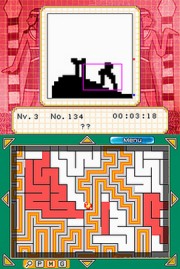 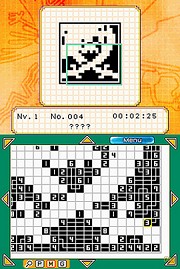 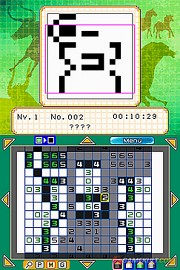
Maze Paint , Drawing and Magipix, in that order.
PIC PIC (505 Games)
One of the few great Japanese puzzlers that HAS been released in
the West, this wonderful game came out some time ago and has been
mentioned on WoS before, but if you missed it and you own a DS, you
really need to prick up your ears round about now, because it's the
best thing since Slitherlink. Comprising three entirely different
puzzle games in one, any of which would justify a release on its
own, Pic Pic offers a stunning 1200 individual puzzles to work
through, with challenge levels for every occasion. The three types
of game in themselves have very distinct difficulty gradings - Maze
Paint, which does exactly what it says on the tin, charges you
simply with finding your way through a maze, using the stylus or
d-pad. As you go, your trail forms a picture on the upper screen
(making pictures being the three puzzle types' obvious link), and
it's a great game for kids (on the earlier stages), or when you want
a time-killer that won't give you a headache from too much
brain-strain.
Moving up a step brings you to
Drawing, which is WoS' favourite by far of the three styles. You're
presented with a grid full of pairs of numbers, which you have to
link by lines. The number of squares connecting each pair is the
number written on them (including the two end squares, so if you
have two "8" blocks there'll be six blank spaces between them), and
you have to draw a line of that length - see the right-hand
screenshot above for an illustration of how it works. It starts off
very easy, with small grids and small numbers and obvious paths, but
by the halfway point you'll be finding "16" and "17" blocks all over
the place in 40x40 grids requiring tortuous, twisted links (with the
numbers in different colours to give you a fighting chance), and the
satisfaction of knocking one of those off is huge. More importantly,
though, because each grid is effectively broken down into lots and
lots of little local minigrids, you're nearly always only thinking
about two or three individual links at a time, so you never feel
hopelessly overwhelmed and every Drawing puzzle is actually fun
while you're solving it.
For hardcore puzzle experts, the third
game type, Magipix, is the real contest. You're faced with a white
grid containing numbers from 0 to 9, signifying the number of
squares in the 3x3 block surrounding the number which ought to be
filled in black (so if you see a "9", for example, you know that
that square and every one touching it need to be black), and that's
all the help you get, apart from the digits lighting up in green
when they have the right number of surrounding squares filled
in (but not necessarily the correct ones). You have to deduce from
the arrangement of numbers which specific squares have to be filled
so that every number is correct, and from very early on it's
murderously difficult. The game quickly stops handing you the 9s and
0s that can be locked in immediately, and you'll frequently find
yourself helplessly staring at the screen and weeping as you try to
calculate multiple levels of possibilities in your head at once just
in order to try to fill in a single square with certainty. It's a
lot like a visual version of Sudoku in that respect, and a lot less
directly enjoyable in mid-puzzle than Drawing is, but when you solve
one and the picture finally reveals itself on the upper screen, it's
so rewarding that you'll want to go out and buy yourself a new car.
There's something for everyone in Pic
Pic, with an excellent interface and simple menu system ensuring
that nothing gets in the way of the pure puzzle solving. 400 puzzles
in each category will keep you going for weeks on end, and the
difficulty curve is well-judged both across the three categories and
within them. While you could make Pic Pic on any format, its natural
home is the DS, and if you have even the tiniest interest in true
puzzle games, it belongs alongside Slitherlink in the ranks of
absolutely essential purchases. 10/10
------------------------------------------------------------------------------------------
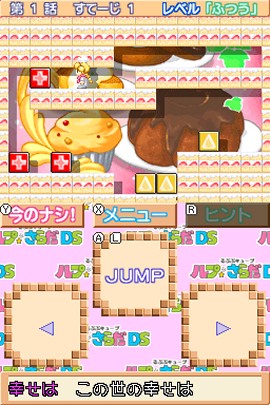 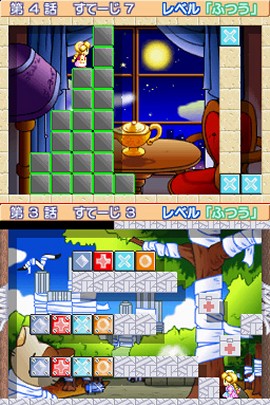
Left: the game as it looks in play. Right: two
different levels shown on top of each other.
LOOPOP CUBE - LOOP SALAD (Dimple)
After that brief and uncharacteristic diversion into UK High
Street action, let's get back to the familiar territory of
Japan-only puzzling weirdness. In a sharp contrast to Pic Pic, the
fantastically exotically-named Loopop Cube - Loop Salad is a game
which really doesn't need the DS at all. It's best played with the
d-pad, and the second screen is entirely wasted space which would
frankly be better used for a pretty picture than the completely
gratuitous stylus-control option that it provides. The game itself
is a cross between Sokoban (the gruelling "classic" puzzler where
you shove crates around a warehouse) and Taito's moderate early-90s
hit Puzznic. (A title that started out as one of those odd Japanese
arcade games where solving puzzles rewards you with pictures of naked
ladies but was converted to all the UK home formats as a straight
block puzzler with all the rude pics rather sadly taken out.)
Loopop Cube's base format into which
its puzzles are built, though, is the platform game. You navigate
your little Alice In Wonderland avatar around single-screen levels
with rudimentary character-square-based controls (including an odd
and initially confusing little double-jump), in order to reach
coloured blocks and push them together. Connect three or more and
they vanish in a cute twinkly explosion, and you have to clear all
the destructible blocks from a level to beat it. As the game
progresses you encounter new types of block (ones that are screwed
down and can't be moved, rainbow ones that will match anything they
touch, Puyo-Puyo style hollow ones that can only be destroyed if
they're touching other blocks that get exploded, grey indestructible
ones that get in the way), but the objective is always the same.
There are, as far as I can reliably
establish, 240 levels, arranged as two difficulty levels each
featuring 12 worlds of 10 levels each. (The menu system is
offputtingly Japanesey at first, but once you've figured out where
the actual game part is you'll never have to worry about the text
again - just click the top-left box, then the two icons you get
are Easy and Hard, and then you're into the levels. The game itself
is totally self-explanatory, with very clear and helpful brief
visual mini-tutorials when a new block type is introduced.) Within a
world you can play the stages in any order, so you're rarely stuck
on a single puzzle with nowhere to go.
The genius of Loopop Cube - Loop Salad
is its restricted scale. While some of the stages are so fiendishly
designed they'll have you tearing your hair out in puzzlement,
they're all so small and with so few options at any given point
(you're also allowed a single-step "undo", which can be used as many
times as you want in a level but not to undo more than one move in
succession) that you'll always feel you're only one flash of
realisation away from beating them. It's a game that frequently makes you feel
incredibly clever when you beat a level that's had you
flummoxed for half an hour, and it's all so colourful and sweet and
pretty that
you never get angry with it even when you're still stuck. One of the DS' most likeable and
enjoyable puzzlers, then, and another import must. 8/10
------------------------------------------------------------------------------------------
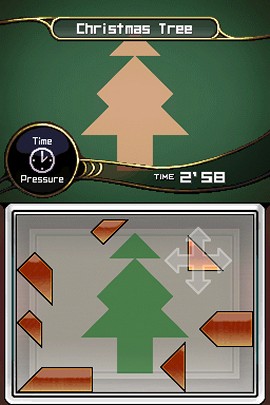 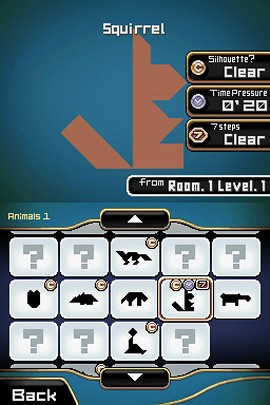
There's a trophy room where you can count all
your medals.
NEVES (Ignition)
The first thing that needs to be said about Neves is "FOR
GOD'S SAKE DON'T BUY TANGRAM MANIA INSTEAD BY MISTAKE". The two
games are such startlingly opposite illustrations of how you ought
to do a tangrams game on the DS that we're not even going to review
505's crushingly awful Tangram Mania in this feature, just to
make sure we don't add to any confusion. Just to recap, though - DON'T BUY TANGRAM MANIA.
Neves, on the other hand, is rather
splendid. Based around the classic cardboard/wooden parlour puzzles
that have been around
for centuries, your task is to fit a collection of seven geometric
shapes into a frame so that they form a picture. The DS interface is
perfectly suited to the game, with a simple and well-executed
interface whereby you grab the pieces by the corners to rotate them
or double-tap to flip them over, and you'll master it in seconds.
There are 500 puzzles to solve in numerous single-player modes, as
well as a one-cart multiplayer where you can race an opponent to
clear stages head-to-head.
The one real design flaw in the game
is that you play the same puzzles in each mode, which renders most
of the game types pointless unless you're disciplined with yourself
about it. The standard mode is Silhouettes, which is simply normal
tangram puzzles that you can solve at your own pace. Time Pressure
mode gives you just three minutes to solve each stage, awarding
medals depending on your speed, and in 7 Steps you have to do
puzzles in, well, seven steps, without making a single mistake,
which is super-tough. Or at least, it would be if it wasn't for the
fact that you can practice every level in Silhouettes mode first,
and then just slap the solution down in Time Pressure and 7 Steps
and collect your gold medal in seconds.
It's a real shame that nobody spotted
this glaringly obvious problem, but if you just pick a single mode
and play through the 500 puzzles on that, regarding the easier modes
with steely disdain as being essentially nothing more than cheating
(or for kids, a bit like the Maze Paint section in Pic Pic), then
you'll still get weeks of good clean fun out of Neves. 7/10
------------------------------------------------------------------------------------------
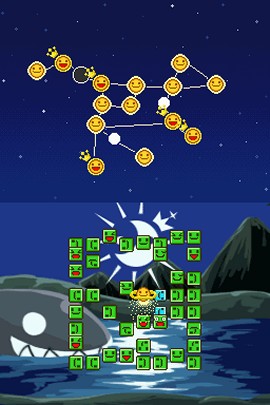 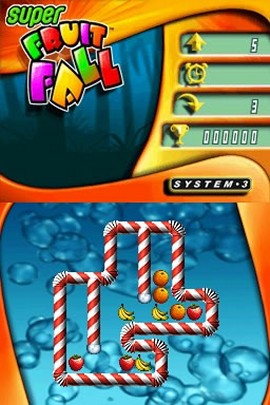
Left: stars. Right: fruit.
KURUPOTO: COOL COOL STARS aka
STARZ (505 Games)
SUPER FRUIT FALL (System 3)
It's odd how hard some games seem to
try to stop you from liking them. Kurupoto gets off to a bad start
with a confusing name that's hard to do a search for (probably why
the European release got the much blander but easier-to-track "Starz"
title), but immediately gets much worse, forcing you into a Story
Mode with interminable, unskippable cutscenes because that's just
what every 2D-puzzle-game fan is looking for - a fucking story.
The first 45 minutes or so of play are a miserable chore, fun simple
introductory levels of puzzles regularly interrupted by endless
screeds of moronic dialogue that nobody in the world will ever read,
but just when you're on the point of giving up before you smash your
DS in with a brick, the game has a striking and inexplicable moment
of blinding epiphany. What?
After you clear the first bunch of
stages, Kurupoto suddenly relents from its sub-Disney tale of
something or other happening to Christ knows who or what in some
place somewhere, and dumps you unceremoniously back to the main
menu, where the hapless player can either continue with the Story
Mode (oh dear Lord no) or gratefully access the
previously-hidden Normal Mode, which lets you ignore all the twee
plotline drivel and get straight into any of the game's 50+ puzzle
levels. At last, a game! Hurrah!
Kurupoto basically plays in the same
way as System 3's Super Fruit Fall. You use the shoulder buttons to
rotate both game's stages in 90-degree steps, causing the contents
of the levels to fall downwards on account of gravity. In each of
Fruit Fall's 30 rounds the object is to make fruits come into
contact with each other, whereupon three or more of the same type
that are connected horizontally or vertically will disappear,
creating more space to move the remaining fruit around in.
Kurupoto's goal is to get your character into the exits of all 56
stages, manoeuvring around the indestructible blue blocks
obstructing his path.
The latter approach works enormously
better. In Fruit Fall, there can be up to 24 pieces of fruit
tumbling around in a level, and you essentially need to be
monitoring every single one of them, because if there are (say) four
oranges and you inadvertently connect three of them, that's the
whole round wrecked and you'll have to start again. There are simply
far too many things flying around for every single rotation move
that you make, and the game quickly degenerates into a random button
mash of jiggling everything around aimlessly and just hoping it all
eventually works itself out somehow.
Kurupoto is much more thoughtful, and
while you can quite often also achieve success with an extended
button-mash, you'll be reduced to such desperation far less often.
(It's also not possible to definitively fail a Kurupoto level in the
way you can do in Fruit Fall, so you never get sent all the way back
to the start.) In addition, Kurupoto awards you a little crown when
you do a stage in the fewest possible moves - Fruit Fall has a Time
Trial mode where you can beat your own best scores, but there are no
"perfect" targets to aim for - so you can repeat each stage until
you can rest easy in the satisfaction of having done it properly.
It's that which ultimately makes it enjoyable, and if you want a
rotatey gravity-puzzle game for your DS it's unquestionably the
smart choice. 7/10 (Kurupoto), 3/10 (Super Fruit Fall)
------------------------------------------------------------------------------------------
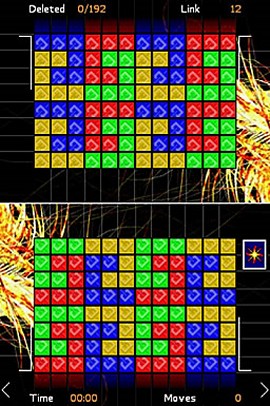 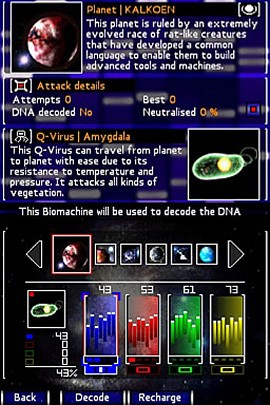
Oh God. It's SO BAD.
DOUBLE SEQUENCE: THE Q-VIRUS
INVASION (Zoo)
And now for a short quiz interlude:
WHY? Why are Western developers so pathologically unable to
grasp the idea of how to make a puzzle game? You might have thought
Konductra was pretty poor (and you'd have been entirely right),
but Double Sequence: The Q-Virus Invasion is just awful
beyond measure - a hideous, overcomplicated, unfathomable,
badly-coded mess that's an ugly disaster from the first seconds when
you boot it up and desperately try to work out how to get to the
actual game part, to the bit where you try to decipher what the hell
you're supposed to be doing (it's got a tutorial, but good luck
relating it to what happens when you have a go at the game), through
to the point where you wonder why the controls only work half the
time for no obvious reason, all the way to the moment where you
finally realise it's not worth the bother and give up while you
still want to live.
In so far as it makes any
sense at all, it seems to be trying to be a sort of cross
between Meteos and being sick, but whatever ideas are actually
buried somewhere deep, dark and cold below the surface were clearly
translated, via Babelfish, from the designers to the cheap Polish
builders they evidently got to actually write it while they were
sitting around idle waiting for some cement to arrive. Probably (where
"probably" is defined to mean "beyond the remotest shred of a sliver
of a shadow of doubt") the worst DS game ever
created. 0/10
------------------------------------------------------------------------------------------
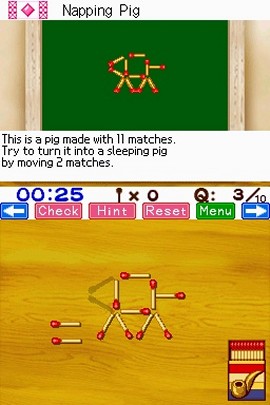
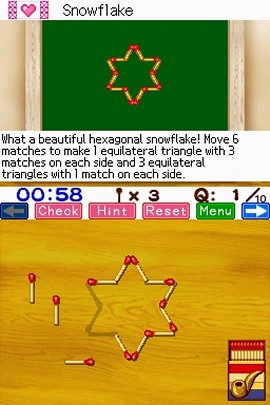
Using a DS to play matchstick puzzles? Cor,
strike a light. (POLICE! - Ed)
MATCHSTICK - PUZZLE BY DS (Ertain)
We can't end like that, so instead let's take a look at the most
minimalist, uncompromising and plain unlikely DS puzzler WoS has yet
found. Matchstick Puzzle (as we'll call it from here, thanks) is exactly what it appears to be - a
collection of, well, matchstick puzzles. Unadorned with any fancy
frippery, you're simply presented with an arrangement of
matchsticks, given a cryptic task to perform by moving, adding or
removing matchsticks, and then left to get on with it. Most puzzles
have either one or two "Hints" available, of varying degrees of
helpfulness, but beyond that there's no safety net - if you can't
solve it, all you can do is skip on to the next puzzle, which is
where what little metastructure the game has comes into play.
There are 160 puzzles, divided into 16
groups of 10. Every time you tackle a particular group, you have to
go through all 10 puzzles, regardless of whether you've done them
before. You can skip puzzles at will both forwards and backwards,
but once you either successfully complete or skip past the 10th
puzzle, you get dumped back on the menu screen and your high score
for the group (eg "7/10") is displayed. Once you've got 10/10 on all
16 groups, all that's left is the Time Attack mode (where you have
to do 10 random puzzles against the clock with no hints and no
skipping, which I haven't managed yet), but it'll be a
while before you get anywhere near that because there are some truly
evil riddles in this game. The "Napping Pig" pictured above is the
3rd puzzle in the whole game, and it perplexed me for an hour and a
half before the clue suddenly made sense and I solved it with a
surge of pride.
The puzzles themselves come in a
variety of types, of which this reviewer's favourites are the
mathematical equations, presented in both Arabic and Roman numerals
and requiring more arithmetic and lateral thinking, rather than the
more abstract spatial manipulation of the geometry-based puzzles, but
there's a good mix to ensure that your brain is kept on its toes
throughout (assuming brains have some sort of cerebral equivalent of
toes). At a teeny 2.2MB there's room for it on the smallest flashcart if you want to give it a tryout first, but if you like
giving your mind some exercise you won't go wrong with this.
6/10
NEXT TIME: 2D PLATFORM GAMES,
MAYBE.
|

